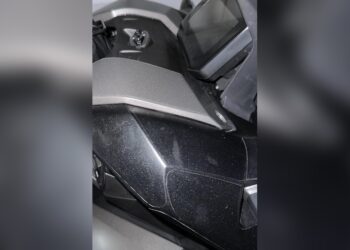You love the sleek look and incredible strength of carbon fiber, but maybe you’ve wondered—does carbon fiber scratch easily? You want your gear, car, or gadgets to stay flawless and sharp, but scratches can happen to anyone.
Understanding how carbon fiber reacts to everyday wear and tear is key to keeping your prized possessions looking their best. You’ll discover the truth about carbon fiber’s scratch resistance, how to spot damage early, and simple ways to protect your investment.
Keep reading to unlock expert tips that will help you maintain that flawless finish for years to come.

Credit: www.reddit.com
Carbon Fiber Basics
Carbon fiber is a strong material made from thin strands of carbon. It is lightweight yet very durable. This makes it popular for many uses.
The structure of carbon fiber gives it unique properties. It combines strength with flexibility. People use it in many industries because of these features.
Material Properties
Carbon fiber is known for its high strength-to-weight ratio. It is stronger than steel but much lighter. The fibers resist stretching and bending. It also resists corrosion and chemicals well.
Its surface is smooth but can be delicate. Scratches can happen if the surface is not protected. Usually, a clear coat covers the fibers to prevent damage.
Common Uses
Carbon fiber is popular in sports, automotive, and aerospace fields. It builds bike frames, car parts, and airplane components. It is also common in electronics and luxury goods.
Many products use carbon fiber to reduce weight and improve performance. Its strong and light nature helps in many practical ways.
Scratch Resistance Factors
Carbon fiber’s ability to resist scratches depends on several key factors. These factors affect how well the material maintains its surface quality under use. Understanding them helps you know what to expect and how to care for carbon fiber products.
Two main elements influence scratch resistance: the surface coatings and the fiber weave with resin. Each plays a vital role in protecting the carbon fiber from damage.
Surface Coatings
Carbon fiber often has a clear coat or protective layer. This coating helps prevent scratches and adds shine. Thicker coatings provide better protection against minor abrasions.
Some coatings also contain hardening agents that improve scratch resistance. The quality of the coating and its application method matter greatly. Without a good coating, the carbon fiber underneath is more vulnerable to scratches.
Fiber Weave And Resin
The pattern of the carbon fiber weave affects surface smoothness and strength. Tighter weaves create a more even surface that resists scratches better. Loose weaves may catch dirt and cause wear over time.
The resin binds the fibers and adds rigidity. A strong resin mix keeps the fibers locked in place and supports scratch resistance. Poor resin quality or curing can weaken the surface, making it easier to scratch.
Types Of Scratches
Carbon fiber surfaces can show different types of scratches. Understanding these scratches helps in proper care and repair. Scratches vary by depth and how they affect the material. Knowing the difference guides you on how to treat them effectively.
Surface Vs. Deep Scratches
Surface scratches only affect the clear coat layer of carbon fiber. These scratches are usually light and shallow. They do not damage the fibers beneath the surface. Deep scratches cut through the clear coat and reach the fibers. These are more serious and need careful attention. Deep scratches can weaken the structure and look worse.
Visual Impact
Surface scratches often cause a minor dullness or haze. They catch the light differently but are less noticeable from a distance. Deep scratches create visible lines or chips. They break the smooth finish and can show white or gray marks. These scratches stand out and spoil the sleek look of carbon fiber. Repairing deep scratches restores both strength and appearance.
Testing Durability
Testing the durability of carbon fiber helps us understand its resistance to scratches. This material combines strength and lightness, but how tough is it against daily wear? Scientists and enthusiasts run various tests to see how carbon fiber holds up under different conditions.
Scratch Tests
Scratch tests involve using tools to apply different pressures on carbon fiber surfaces. These tests show how easily the material’s outer layer can be marked or damaged. Results often reveal that carbon fiber resists light scratches well, thanks to its clear coating. Stronger forces can still leave marks, but the fibers beneath usually stay intact.
Real-world Scenarios
Testing in real-life situations gives a better idea of carbon fiber’s durability. People use it in bikes, cars, and phone cases, where contact with rough surfaces is common. Observing wear from everyday use shows that carbon fiber handles minor scratches better than many plastics or metals. Proper care, like cleaning dust gently, keeps the surface looking new longer.
Repairing Scratches
Repairing scratches on carbon fiber surfaces requires care and the right approach. Minor scratches often need simple fixes to restore the look. Deep damage might demand more work to ensure strength and appearance return. Understanding these repair methods helps maintain carbon fiber’s unique beauty and durability.
Minor Scratch Fixes
Small scratches on carbon fiber usually affect only the clear coat. Light polishing with a fine abrasive compound can remove these marks. Use a soft cloth and gentle pressure for best results. After polishing, apply a protective wax or sealant to keep the surface smooth. This method is quick and keeps your carbon fiber looking new.
Deep Damage Restoration
Deep scratches may expose the carbon fiber weave underneath the clear coat. These need careful sanding to smooth the edges around the damaged area. After sanding, apply a clear resin or epoxy resin to fill the scratch. Let the resin cure fully before sanding it flat again. Finally, polish the surface to blend the repair with the rest of the finish. For large or structural damage, professional repair is recommended to keep strength intact.

Credit: www.reddit.com
Preventing Damage
Preventing damage to carbon fiber surfaces extends their life and keeps them looking great. Carbon fiber is strong but can still get scratched if not cared for properly. Taking simple steps helps maintain its sleek finish and durability.
Regular cleaning and protective actions reduce the risk of scratches. Avoid harsh treatments that may harm the clear coat or fibers beneath. Gentle care preserves the material’s natural strength and beauty over time.
Cleaning Tips
Use a soft microfiber cloth to clean carbon fiber surfaces. Avoid abrasive materials that can scratch the finish. Mild soap and water work well for removing dirt and grime.
Rinse thoroughly to remove soap residue. Dry gently with a clean cloth to prevent water spots. Clean regularly to stop dust buildup, which can cause scratches during wiping.
Protective Measures
Apply a clear protective coating designed for carbon fiber. It adds a barrier against scratches and UV damage. Use paint protection film on high-contact areas for extra defense.
Handle carbon fiber parts carefully to avoid accidental hits. Store items in padded cases or soft cloths to prevent rubbing. Avoid sharp objects near the surface to keep it scratch-free.
Handling Carbon Fiber Safely
Handling carbon fiber safely is essential to prevent discomfort and maintain the material’s quality. Carbon fiber can cause minor skin irritation if fibers come into contact with your skin. Understanding how to avoid and treat these irritations helps ensure a smooth experience when working with or using carbon fiber products.
Proper handling also protects the carbon fiber surface from scratches and damage. Taking precautions reduces risks and keeps both you and the material safe.
Skin Irritation Causes
Carbon fiber fibers are very small and sharp. They can easily pierce or scratch the skin’s surface. These tiny fibers cause itching, redness, and mild irritation. The irritation is similar to a mild rash or a scratch.
Contact with broken or unfinished carbon fiber parts increases the chance of irritation. The fibers can become airborne and settle on your skin, causing discomfort.
Removal Of Fibers From Skin
Wash the affected area gently with soap and cold water. This helps remove loose fibers without pushing them deeper. Avoid scrubbing harshly.
Use sticky tape or a lint roller on the irritated skin. Press the tape down firmly and lift it off to pull out trapped fibers. Repeat as needed.
For stubborn fibers, soak the skin in warm water to open pores. This makes it easier to remove the fibers.
Soothing Skin Irritations
Apply a cold compress to reduce itching and swelling. Use a gentle moisturizer to soothe the skin.
Topical corticosteroid creams can help calm more severe irritation. Use these creams as directed by a healthcare professional.
Keep the skin clean and avoid scratching to prevent infection and further irritation.
Protective Gear Recommendations
Wear gloves when handling carbon fiber to protect your hands. Long sleeves and safety glasses help shield skin and eyes from fibers.
A dust mask or respirator prevents inhaling airborne fibers. Work in well-ventilated areas to reduce fiber buildup in the air.
Use protective clothing that you can wash separately to avoid spreading fibers to other clothes or skin.
Credit: f90.bimmerpost.com
Frequently Asked Questions
Is Carbon Fiber Scratch Resistant?
Carbon fiber resists scratches better than many materials but is not completely scratch-proof. Its clear coat protects fibers underneath. Regular cleaning prevents swirl marks and surface damage. Handle with care to maintain appearance and durability.
How To Protect Carbon Fiber From Scratches?
Clean carbon fiber regularly with a soft cloth to remove dust. Apply a clear coat or protective film. Avoid abrasive materials and harsh chemicals. Store items carefully to prevent contact with sharp objects. Use gentle washing techniques to maintain the surface finish.
How To Get Rid Of Carbon Fiber Itch?
Gently wash the skin with soap and cold water to remove fibers. Use sticky tape or a lint roller to lift remaining particles. Soak in hot water to open pores. Apply moisturizer or a corticosteroid cream to soothe irritation. Avoid scratching to prevent worsening the itch.
Does Carbon Fiber Splinter?
Carbon fiber can splinter if damaged, releasing tiny sharp fibers. These splinters may irritate skin and cause itching. Handle carbon fiber carefully to avoid splinters and wear protective gear during cutting or sanding.
Does Carbon Fiber Scratch Easily?
Carbon fiber is scratch-resistant but can still get scratched by hard or sharp objects.
Conclusion
Carbon fiber resists scratches better than many materials. Still, it can get scratched by sharp or rough objects. Regular cleaning helps keep its surface smooth and shiny. Avoid rubbing dirt harshly to prevent marks. Use gentle methods to remove dust and debris.
Taking simple care steps extends carbon fiber’s life and look. It remains a strong, lightweight choice for many uses. Small scratches are normal but usually do not affect performance. Keep carbon fiber protected, and it stays durable and attractive.

















